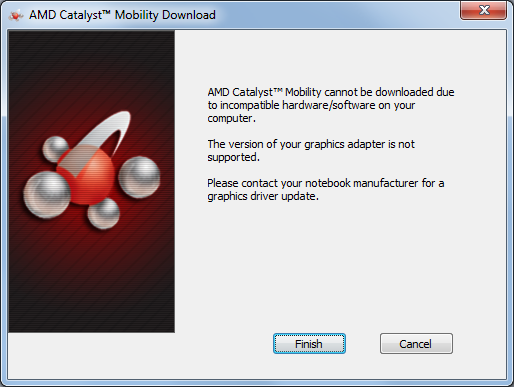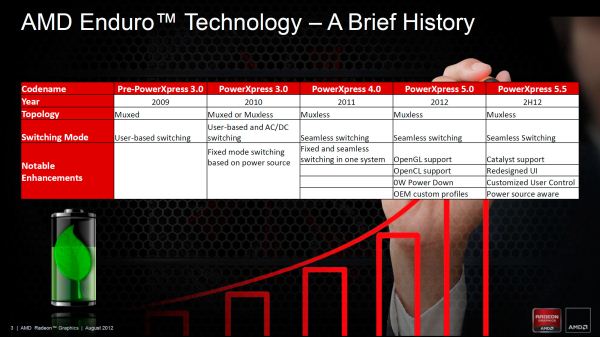AMD’s Enduro Switchable Graphics Levels Up
by Jarred Walton on September 6, 2012 3:00 AM ESTRecap: AMD’s PowerXpress, aka Dynamic Switchable Graphics, aka Enduro
Getting back to the switchable graphics, AMD has gone through a variety of names over the years. Here’s AMD’s summary slide, which I’ll discuss in detail:
Originally introduced as PowerXpress back in 2008, the first AMD switchable graphics solutions were like that found later in the ASUS UL80Vt and similar laptops: you had to flip a switch, and in the first iterations you would then need to reboot the laptop so that the BIOS could disable the discrete GPU and activate the integrated GPU. It was messy and a bit inconvenient, and NVIDIA’s early studies showed that many users ended up not using the feature—they would either run on dGPU all the time or on iGPU all the time. Both AMD and NVIDIA had a second series of switchable graphics designs where the need to reboot was removed; the first Alienware M11x could switch GPUs in about 10-15 seconds, and the same was true of HP’s first ENVY laptops. These were using PowerXpress 2.0 and 3.0, and for most people the switching side was adequate: you’d run on dGPU when plugged in and switch to iGPU when on battery power.
Last year, AMD took a step forward with their switchable graphics by introducing PowerXpress 4.0, which also renamed the technology to Dynamic Switchable Graphics (DSG for short). I got a chance to do a head-to-head of the technology using a Sony VAIO C laptop provided by NVIDIA. You know a company is confident that they’re going to win a technology comparison when they’ll actually give you a competitor’s product. In some cases, DSG was just as good as Optimus: you could launch a supported game and never realize all the extra stuff happening in the background; unfortunately, there were several titles where it wasn’t quite as convenient as we would have liked, and OpenGL support from DSG was completely missing.
Step forward to early 2012 and we got another update to PowerXpress 5.0 (note that PowerXpress is now only used internally by AMD and hasn’t been their marketing name since before PX4.0) along with a rechristening: Dynamic Switchable Graphics was out and Enduro was in. If nothing else, at least it makes my job easier as Enduro is much more concise. There's also the fact that the GPUs are no longer "switching", as the iGPU is always running; now the dGPU is simply supplementing the iGPU when needed. Along with the name change, AMD added OpenGL and OpenCL support to the mix, and with their Zero Core Technology (which is also part of their 7000 series desktop GPUs—a case of mobile design influencing desktops) the need to keep a small portion of the chip alive (aka BACO: Bus Active Chip Off) was removed. OEMs could also ship with custom profiles for applications, so for example Dell might want all of their extra utilities to default to running on the iGPU.

Hopefully this problem goes away next month!
Other than those changes, the UI and driver updates situation on early Enduro solutions remains largely the same as with DSG/PX4.0—and that’s what I initially received with the Clevo P170EM, with drivers from around March 2012. A quick check at AMD’s site also let me know that there weren’t any new drivers available, as the P170EM wasn’t currently supported by the latest Mobility Catalyst drivers.











200 Comments
View All Comments
Vozier - Thursday, September 6, 2012 - link
Again great work Jarred, your help is like a boat in the middle of the ocean for many here.Maybe you can forward the GPU usage %s to AMD, who knows if they are aware of this.
some other games you might test are:
Crysis 2
Witcher 1 and 2
Skyrim
BF3 (specially multiplayer)
What everybody here wants is that GPU can be assigned, fixed, forced, you name it to work 99% at any setting or game we want it to, to forget about power saving. Maybe thats easier to get faster than a working "60fps minimum performance" solution.
and again thanks! I will definetely buy from anadtech in the future, just for this.
regards
Voz
Zoomer - Friday, September 7, 2012 - link
That's not going to happen. The frames are transferred over PCIe, and that's a limited shared resource. Uncapping it would just take away bandwidth and increase latency for the other unimportant stuff, you know, like textures and geometry.arcticjoe - Saturday, September 8, 2012 - link
Nvidia can do it, why cant AMD? Otherwise its a little unfair for consumers who pay ridiculous money for a top of the range card that also has a major with a design flaw severely limiting its performance.Woodchuck2000 - Thursday, September 6, 2012 - link
Any chance of Anandtech investigating this issue? Reading through the support forums, it doesn't look like user complaints have made a difference. I suspect that if a site like Anandtech publishes some hard numbers, we'll actually see a fix for these issues.JarredWalton - Thursday, September 6, 2012 - link
There have been no driver updates since launch for Clevo 7970M users, so of course there haven't been any fixes. AMD is basically saying step one is to get support for Enduro laptops into their regular Catalyst driver updates, and once that's done end users should see fixes at the same time desktop drivers get fixes. This has not yet happened, but it's supposed to happen by the end of the year.arcticjoe - Thursday, September 6, 2012 - link
There may not be any official releases for Clevo, but you can install most mobility releases on a EM series laptop, including the latest 9.0 leak (Catalyst 12.8). They all work in games, but the issue with GPU under-utilization remains the same in all releases so far.Also, 7970m was released in March - not being able to use it properly for the majority of its lifecycle as the top mobile AMD card is really pathetic.
JarredWalton - Thursday, September 6, 2012 - link
I don't know if others are having better luck, but at least when I tried installing the non-Enduro Catalyst drivers on the P170EM it did nothing good. I think I got the updated Catalyst control panel but still running old drivers. Hacking drivers to get them to install is not the same thing as having proper driver support. Enduro has a lot of lower level stuff going on in the drivers that regular discrete-only cards don't have to consider. If they work at all, I'm surprised, but I wouldn't expect 100% optimal performance from them.TokamakH3 - Thursday, September 6, 2012 - link
You've nailed AMD's major problem on the head with this statement. No official drivers for the 7970M since launch, what 4 months ago? With a whole portion of the owners practically screaming that the GPU is garbage in the latest games? The only 7970M owners who are happy are those that can completely disable Enduro via the BIOS. That's absurd.krumme - Thursday, September 6, 2012 - link
For the past 3 years amd have had the best, most efficient, arcitechture for for mobile market, and even still for this generation something that can compete with kepler.How on earth they can bring themselves in a situation not having a product similar to optimus is one of the biggest management failures. Is simply unforgiving. What were they thinking on?
Instead of focusing on fx crossfire with absolutely no economic importance, they have let this obvious technology take 2 years later than it needed to. With amd insight, they should be 1 year ahead of nv here. Pathetic management, and it was obvious 2 years ago.
AMD strategic decisions is always some technical extreme long term roads. Like APU could save their mobile business. Man, its sad to watch. Engineering thinking when it fails.
There have been a lot of people leaving AMD lately, and lots of tears for that. Well, they might be technically good, but business people they were not.
RR have a lot to do at AMD to clean up this mess.
JarredWalton - Thursday, September 6, 2012 - link
"With amd insight, they should be 1 year ahead of nv here."Wait, exactly why would anyone expect AMD to have better insight than NVIDIA? Or Intel? Isn't this the same company that underdelivered on Bulldozer? And K9 basically never happened because it was so far off of what was needed? AMD has the potential to compete and even exceed NVIDIA and Intel, but while they have done so on occasion there's no reason to say they should consistently be ahead.